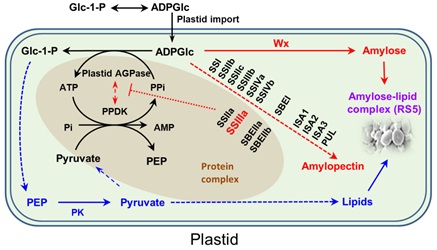
Resistant starch (RS) refers to starch and starch degradation products that escape from digestion in the small intestine of healthy individuals. Foods high in RS could potentially protect against pathogen infection, diarrhea, inflammatory bowel disease, etc. Global average RS intake is dramatically lower than the recommended for beneficial health, and hot cooked rice typically contains <3% RS. Improvement of the amounts and properties of RS in foods is an important goal for rice breeding, but strategies to increase RS in rice are limited due to a lack of knowledge of its molecular basis.
Through map-based cloning of a new RS locus in indica rice, the groups of Prof. LI Jiayang at the Institute of Genetics and Developmental Biology (IGDB) of Chinese Academy of Sciences and Prof. WU Dianxing at Institute of Nuclear Agriculture Sciences, Zhejiang University, identified a defective soluble starch synthase gene (SSIIIa) responsible for high RS production. The resulting high RS has modified granule structure, high amylose, lipid and amylose-lipid complex, and thus has altered physico-chemical properties. In-depth studies showed that RS production is dependent on the high-expression of the Waxya allele.
Based on these findings and previously published results, researchers proposed that the loss of function of SSIIIa would disrupt the protein complex consisting of PPDK, SSIIIa, AGPase, SSIIa, SBEIIa and SBEIIb. This will reduce the influence on PPDK and AGPase activities so that relatively more ADPGlc is directed towards glycolytic intermediates to support lipid biosynthesis via the action of pyruvate kinase. Meanwhile deficiency in SSIIIa will decrease amylopectin biosynthesis, resulting in a shift in carbon allocation towards amylose biosynthesis by GBSSI encoded by the Waxy gene. Consequently the increased levels of amylose and lipids together give rise to an increase in amylose-lipid complex constituting, constituting RS type 5 (RS 5).
The discovery not only provides a promising approach to develop new rice lines rich in RS but also shed light on RS biosynthesis in other major cereal crops. The study entitled “Critical roles of soluble starch synthase SSIIIa and granule-bound starch synthase Waxy in synthesizing resistant starch in rice” has been published online in PNAS. This journal also published an invited commentary which highlights the work for its scientific significance and potential applications in crop breeding.
This work was mainly supported by the Chinese Ministry of Science and Technology grant, the Strategic Priority Research Program of the Chinese Academy of Sciences.


86-10-68597521 (day)
86-10-68597289 (night)

52 Sanlihe Rd., Xicheng District,
Beijing, China (100864)

